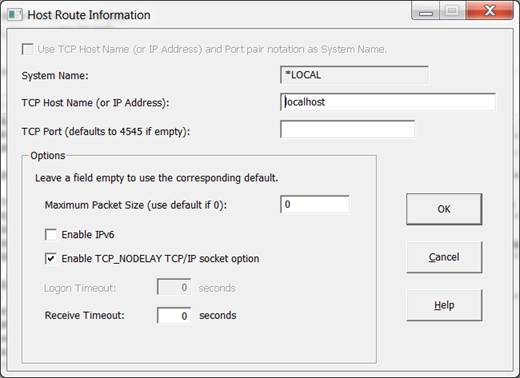2.2 Add or Change a Host Route
If you have selected the New or Edit buttons on the main window, the dialog box is displayed.

The route record created using the Host Route Information dialog is not required if you are using the default TCP host name/port pair format.
The default setting for host name is localhost, and the port is 4560. (When calling the host name, just set it to localhost:4560.)
If you are not using the default host route, please continue with the options on this dialog:
Use TCP/IP Host Name (or IP Address) and Port pair notation as System Name
Select this option to use a generated LU name for TCP host name/port pair format.
System Name
Enter the name of a host to which you want to connect.
For LANSA Open, this is the name used in a call to LceUseSystem.
Tip
When defining an IBM i system, it may save you time if you define it twice with different Partner LU Names. For example, if your IBM i LU Name was MYHOST, then you could define it under the LU Names MYHOST and APPN.MYHOST. The two entries should be identical in all other respects. Using this approach allows your applications to use either the short name MYHOST, or the more formal name APPN.MYHOST. For example, the Visual LANSA Host Monitor always uses the formal name APPN.MYHOST, so unless you specify the formal name the host monitor will fail to start. However, the ability to also use the shorter name MYHOST is simpler and easier to remember for other applications.
TCP Host Name (or IP Address)
The address of the host may be a simple host name for a host in the same domain, a fully qualified host.domain name, or an IP address in nnn.nnn.nnn.nnn format. Note that when a name is supplied, name resolution (to an IP address) is provided by the underlying TCP/IP protocol stack, with which you should be familiar.
TCP Port
The default port number is 4545.
If used, the Listener component on the host must also be configured to listen on this port number.
Options
If you leave any of these options blank, the default will be used.
Maximum Packet Size
Simulates APPC packet sizes by determining the size of the send buffer used internally. The default is 1024 plus the size of a header. It is recommended that this parameter is left with the default, but it may be set by a networking specialist configuring for special circumstances.
Default to zero (0) to use the system default.
Enable Ipv6
Select this option to enable Internet Protocol version 6 support. This option enables the application to work on both the IPv4 and IPv6 network.
Enable TCP_NODELAY TCP/IP socket option
Select this option to disable the Nagle algorithm to allow small data packets to be delivered to the remote host without delay.
The Nagle algorithm combines multiple send calls in a small data buffer and delays sending it until an acknowledgement for the previous data packet sent is received from the remote host. It is enabled as the default in TCP/IP socket.
As the LANSA Communication Extensions implements its own data buffering, the Nagle algorithm is not needed.
Logon Timeout
Reserved for future use.
Receive Timeout
If no data is returned from the application server in the specified time in seconds, the connection is automatically closed and an error is returned to the client application.
The default of 0 second that means no timeout at all. That is, the client application would wait indefinitely until application server replies.
It is recommended that this parameter is left with the default, but it may be set by a networking specialist configuring for special circumstances.
When you have completed your entries, press . This will generate the lroute.dat file to be used.
DO NOT manually alter the lroute.dat file. If further changes are required, use this dialog to enter them.